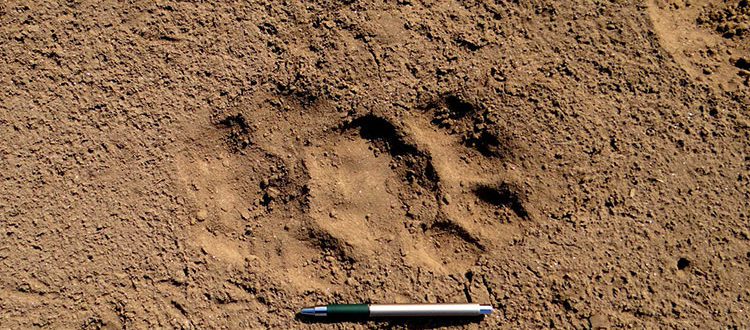First-hand Account: Capturing the Man-eater of Pilibhit
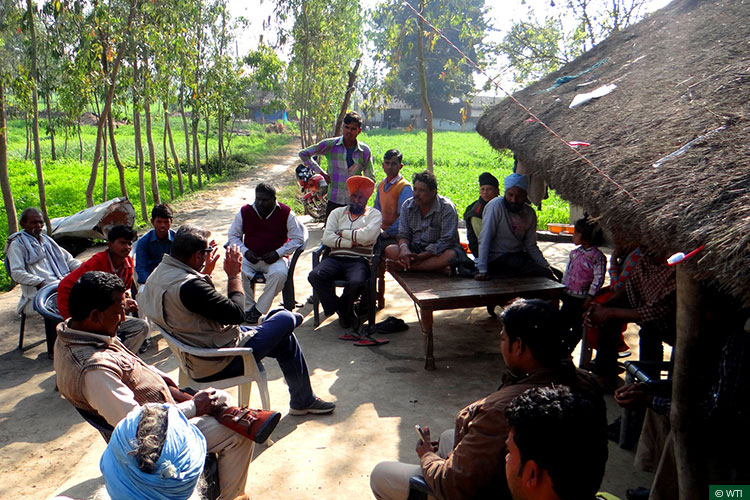 The WTI team and forest department officials meet with villagers at the home of one of the victims
The WTI team and forest department officials meet with villagers at the home of one of the victims
Pilibhit Tiger Reserve, February 20, 2017: Nine days ago, a Rapid Response Team established under Wildlife Trust of India’s (WTI) UP Carnivore Conservation Project assisted the Uttar Pradesh Forest Department in tranquilising and capturing a tiger that was declared a man-eater after having killed multiple people in the fringe areas of Pilibhit Tiger Reserve. Shoot orders had been issued against the tiger, which meant there was a limited opportunity to resolve the situation without killing it.
The following is a first-hand account by the two WTI team members involved in the operation: Dr Aaron Wesly, project veterinarian and Prem Chandra Pandey, project sociologist.
On the evening of February 7, the Conservator of Forests – Bareilly and the Divisional Forest Officer – Pilibhit Tiger Reserve (Wildlife) called to inform us about a crisis situation: two people had been killed and another injured in tiger attacks that had occurred on consecutive days in certain fringe regions of Pilibhit since February 5.
We proceeded to the Mustafabad Forest Rest House in Pilibhit the next morning, to attend a high-level meeting involving the Principal Chief Conservator of Forests (Wildlife), the Chief Conservator of Forests – Bareilly, the Conservator of Forests – Bareilly, the Divisional Forest Officer – Pilibhit, and the concerned Range Forest Officers. A control room was established for the operation, teams were formed and landscapes allotted to each team to track down the tiger through active patrolling. The team that would attempt to tranquilise the tiger was also decided – the two of us from WTI, Lucknow Zoo veterinarian Dr Utkarsh Shukla, former WTI veterinarian Dr Saurabh Singhai and two other local animal husbandry veterinarians. In addition, with the tiger now having officially been declared a man-eater, the Conservator Mr PP Singh was tasked to be the designated shooter in case tranquilisation attempts should fail, and a .375 rifle and bullets were issued to him. It was also decided that awareness meetings would be conducted in the affected villages and safety leaflets distributed.
Six people had been killed and one injured in tiger attacks in the fringe areas around the Barahi and Mala forest ranges of Pilibhit since November 28, 2016. The situation had escalated since February 5, with an attack occurring every day. These last three attacks (two kills and one where the victim was injured) had a similar pattern: humans sleeping outdoors in mosquito nets were attacked and the limbs on one side consumed; the tiger had in each case not gone after livestock that presented an easier, close-to-natural prey. After one of the kills a nearby camera trap had recorded a picture of the killer, so we were sure which tiger to look for.
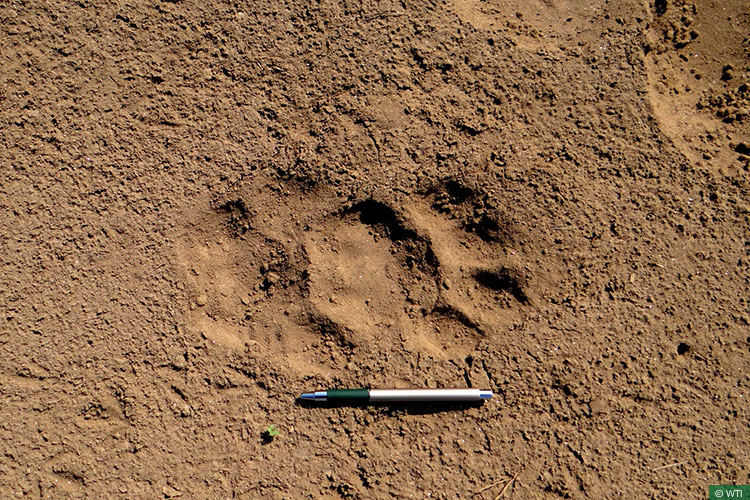 A pugmark spotted at the village of Navadiya, near where the tiger was tranquilised
A pugmark spotted at the village of Navadiya, near where the tiger was tranquilised
We got to work immediately, visiting each kill site, meeting relatives of the victims and conducting awareness sessions in conflict-affected villagers. The next day the various teams began tracking tigers in their allotted areas; we were part of the team for Shahgarh village and its surrounding regions. We worked with forest department staff and our tracking endeavours received further strength with the assistance provided by local villagers. We distributed our contact details to a few key people in conflict villages, asking them to share any information about the tiger’s presence so that we could act swiftly.
On February 10, the gram pradhan (village head) of Karnapur called the control room, informing us that his pet dog had been attacked by an animal early in the morning. We proceeded to his home and found an open bleeding wound on the dog’s right thigh, exposing the musculature. Aaron (Dr Wesly) provided the necessary emergency treatment but we couldn’t be sure that the bite had indeed been caused by a tiger.
The last three attacks had a similar pattern: humans sleeping outdoors in mosquito nets were attacked and the limbs on one side consumed
Reports of tiger sightings kept coming in through the course of the day. Our team reported to several sites as first responders, but our efforts through the day turned out to be fruitless. We had conducted seven awareness meetings with conflict-affected villagers over the last three days and distributed extension aids regarding the do’s and don’ts during human-tiger conflict, but there was no confirmed sighting – though thankfully, also no human kill. However, an unusually dense fog crept across the landscape at dusk and we expected to hear some sort of news in the morning.
A Situation on the Boil
Early on February 11, before 6.00am, we received the news from the Range Officer of Mala that another person had been killed, this time in Kalinagar village under the Barahi forest range. Our team was en route when we received news that the villagers were very agitated and we would be risking our lives if we entered the village. The forest department also suggested that we hang back from the area for a while. So, we left our rescue vehicle a kilometre from the village, hung our cameras around our necks and with pocket diaries and pens in hand, decided to continue towards the kill site, pretending to be journalists!
We analysed the situation and informed the forest department that things were under control now that the police had arrived on site. Having collected all the necessary details of the incident, we found that the killing and consumption pattern was the same as in the other recent kills, raising the probability that the same tiger was responsible. The crowd that had gathered pointed us in the direction that the tiger had gone, and we found pugmarks confirming the same.
While officials from the forest department arrived and tried to recover the victim’s body, we began tracking the tiger. We proceeded approximately two kilometres on foot, following the pugmarks, and reached a PWD road. As we wondered which way to go, a villager came up to us and said that a tiger’s pugmark had just been found at Navadiya village half a kilometre away. Sure enough, we found a fresh set of pugmarks at the village and asked the department to bring in trained elephants immediately – we had a gut feeling that the tiger was still present in the area.
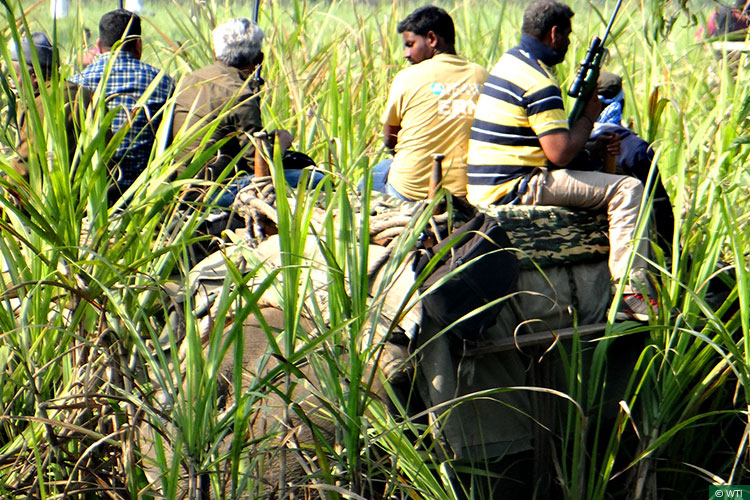 Two trained elephants move through the sugarcane with the tranquilising teams
Two trained elephants move through the sugarcane with the tranquilising teams
The forest department staff arrived half an hour later and two untrained elephants an hour after that – the trained elephants were stationed further away and it would take them a while longer to reach the area. We clambered onto one of the elephants and started combing the area. Suddenly, we came upon the tiger in a sugarcane field! Even as we tried to tranquilise it, it attacked and injured the elephant we were on. It had in fact launched itself at the mahout and us, but since it could not get a good enough foothold we had a narrow escape. Both elephants were terrified and ran away from the area, beyond their mahouts’ control.
By now the full team had reached the area – higher officials of the forest department, Dr Utkarsh Shukla from Lucknow Zoo, Dr Saurabh Singhai, the local veterinarians and the WWF team. We decided to cordon off the sugarcane field with nets before the trained elephants arrived on site. A JCB land mover and a crane lift were also called for and a drone surveillance team was kept at the ready. Finally, the operation had taken a highly professional and organised turn.
The Endgame
The trained elephants arrived two hours later. Dr Shukla and the Conservator Mr PP Singh climbed onto one of the trained elephants while both of us climbed onto the other. Dr Saurabh Singhai and a WWF team member were astride one of the untrained elephants and the two local animal husbandry veterinarians from Pilibhit were seated on the other. The mahouts were told to stand all four elephants side-by-side, while the JCB would go on ahead, clearing the sugarcane to give us a better chance of clearly seeing the tiger.
Leaving a narrow strip of sugarcane alongside the net cordon, the JCB made a circumferential clearing within the sugarcane field. Suddenly, the tiger made a dash towards the periphery, only managing to entangle itself in the nets. We approached it with the four elephants but it freed itself in a trice, charging once again at the elephants in an attempt to get back into the thick vegetation in the middle of the field. Mr PP Singh was now frantically firing his rifle into the air to scare the tiger.
The two trained elephants charged back at the tiger, trumpeting and roaring loudly, and we almost lost our balance. Our hearts skipped a beat when the tiger leaped past us, its mouth just a foot away from our dangling legs. We turned back to see that two untrained elephants had already run out of the cordoned area, and their riders were already standing on the ground!
Now only the two trained elephants remained, continuing the task shoulder-to-shoulder. The tiger was sighted again, hiding inside the sugarcane. Both tranquilising teams had the narrowest of opportunities to take their shot. Dr Shukla, the senior and experienced vet that he is, took his chance. He was on target, thankfully, for if his attempt had failed, the tiger would have had to be shot dead.
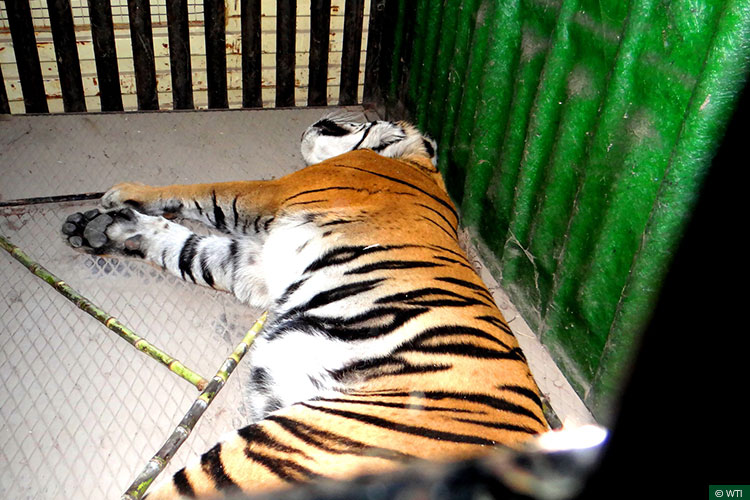 The tiger in a transport cage after it was finally tranquilised
The tiger in a transport cage after it was finally tranquilised
Even before we could get our breaths back, the massive crowd of onlookers, a gathering of more than 5000 who had been watching from a distance, rushed towards the sedated tiger with sticks and whatnots. We jumped off the elephants, which now had to be used to drive the crowd away from the sedated tiger! Finally, after an hour of strenuous effort the tiger placed into a cage.
The active tranquilising operation had stretched for a period of five hours. At the end of it, a tiger that was to be shot was instead tranquilised to be sent to Lucknow Zoo. Although letting wild remain wild is the conservation motto and a lifetime in captivity is not the ideal outcome, it was, we felt, still a happy ending. The tiger had not been put down, and it would cause no further human deaths. In the end, both animal and human lives matter.

